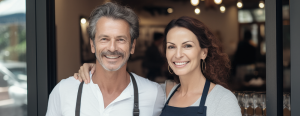One of the most important decisions you’ll have to make as a small business owner is choosing the right business entity for your company and your business goals. Your business entity determines your company’s structure — which will determine how you pay your taxes, run your business, the types of documents you’re required to file, and more.
When starting a business, figuring out which one of the several available options is right for you — from LLCs to S Corporations and C Corporations — can be overwhelming. While many small businesses start out as sole proprietorships or partnerships, business owners may choose to incorporate their businesses to protect personal assets from company liabilities, such as lawsuits and debt.
C Corporations (C Corps) have become increasingly popular among business owners since the 2018 tax reform changes. C Corps now offer small businesses more advantages, such as greater ownership flexibility and unique tax benefits.
Let’s look at some of the top tax benefits of C Corps — and how they compare to the different types of business entities when it comes to taxation.
For expert knowledge about corporate double-taxation and other common concerns from small businesses about corporate entities, check out CPA Answers.
Pass-Through Business Entities: How Sole Proprietorships, Partnerships, LLCs, and S Corporations are Taxed

Sole proprietorships, partnerships, LLCs, and S Corps are all pass-through entities, meaning that their profits and losses are “passed through” to the owners or shareholders. This means they do not distribute income tax to their owners or shareholders in the same way as C Corps.
C Corps aren’t pass-through entities, which means they can offer many unique advantages — and possible disadvantages — for small businesses. Generally, C Corps are more complex and rule-heavy compared to their counterparts. With strict reporting requirements, federal regulations on taxes, and shareholder voting rights, many may opt to register their business as a pass-through entity.
But C Corps can also be advantageous for many small businesses, offering unique tax benefits and financing opportunities, such as 401(k) business financing. Before we break down the top tax benefits of C Corps, let’s review some of the biggest pros and cons of common pass-through entities that you should know about.
What’s a business entity? Get an overview of LLCs, C Corps, S Corps, and more here.
Pros of Pass-Through Business Entities

Tax Benefits
The biggest differences between business structures emerge clearly around tax time. The majority of small businesses in the U.S. are pass-through entities: sole proprietorships, partnerships, Limited Liability Companies (LLCs), and S Corps (small business corporations governed by Subchapter S of the Internal Revenue Code). In a nutshell, this means their profits are “passed through” to the owners and shareholders, who then report business income or losses on their personal tax returns. Pass-through entities are not required to pay corporate taxes.
Under the 2018 tax reform, pass-through entities may also be able to qualify for a 20 percent deduction on taxes due for pass-through income. For example, if a small business has $100,000 in income that will be passed through, only $80,000 of that would be taxable under the current tax law.
Did you know you can run an LLC through a C Corp — reaping some of the benefits from both business structures? Learn more in C Corp to Run LLC.
Cons of Pass-Through Business Entities
Income Taxes and Self-Employment Taxes
While pass-through entities aren’t subject to corporate taxes, it’s important to note that pass-through entities still receive ordinary income taxes and self-employment taxes that must be paid on that amount as well that passes through, in lieu of payroll taxes that would be applicable with C Corps.
Tax Disincentives: Limits the Growth of Your Business
Pass-through entities may incentivize business owners to report a smaller income while taxing the pass-through income according to the ordinary tax rate. For example, if you claimed a pass-through income of $200k, your ordinary income tax rate would be 32 percent, according to the 2023 Federal Income Tax Brackets for SINGLE filers (2023 Tax Brackets and Federal Income Tax Rates | Tax Foundation). If you filed taxes as “Married,” however, the tax rate would be 24 percent.
While you may save more money in the short term by reducing your taxable income by filing your taxes with these considerations in mind or writing off non-business-related expenses, it can lead to big problems down the line.
For one, if the business provides your sole source of income for your household, excessive write-offs and minimal profits reported can significantly impact your ability to prove your income and profitability when applying for nearly any type of loan, including auto and SBA loans — which can make loan approvals more challenging.
When the time comes to sell your business, the tax returns may also show very little profit, impacting the perceived value of your business. In turn, your business can have a lesser chance of finding an interested and high-paying buyer.
Increased Audit Risks in the Face of the IRA Bill
It should also be noted that the recent measures from the Biden Administration, such as the Inflation Reduction Act of 2022, will provide substantial funding and support for the Internal Revenue Service (IRS) in the coming years. While more funding for the IRS is mostly a good thing, you should keep the increased oversight on your radar. The IRS has been understaffed for nearly a decade, lacking the technology and resources needed to collect due taxes properly. This $80 billion funding aims to expand the IRS workforce and efficiency, which likely means a future increase in IRS audit rates.
The Treasury and the IRS have indicated that these audit rates will primarily affect businesses and individuals making more than $400,000 annually. Still, the gross number of audits for all taxpayers is anticipated to increase over time — and because of its unique tax incentives, the IRS may keep an even sharper eye on pass-through entities in the next few years.
In general, pass-through entities like LLCs and S Corporations are more likely to be audited based on their direct incentives to report fewer profits. C Corps, however, does not work this way — the amount of net profit is always taxed at the same 21 percent amount. Pass-through entities typically report less in profits to avoid being placed in a higher tax bracket, which makes it more challenging for those businesses to grow compared to C Corp businesses.
Learn more about the Inflation Reduction Act of 2022 and how it could impact small businesses in the long term.
Non-Pass-Through Business Entities: How C Corporations Are Taxed Under the 2018 Tax Reform

The main difference between a pass-through entity and a C Corp is that C Corps legally separates owners’ or shareholders’ assets and income from that of the corporation, meaning it’s completely independent of you as a business owner when it comes to taxes. This in no way means a C Corp is tax exempt — but rather, any earnings are taxed at the corporate level, and any dividends distributed to shareholders are also taxed at their personal level. This is often referred to as double taxation.
Many small business owners can avoid pursuing a C Corp after hearing the term “double taxation.” But double taxation doesn’t mean your business is taxed twice. This simply refers to a C Corp being taxed at both the corporate level and individual level.
This separation of personal assets and liabilities from business assets and liabilities can protect your business more than any other type of entity. With C Corps, your personal assets are far less visible and accessible in a potential lawsuit.
On the other hand, there’s only one tax return that combines personal and business assets or liabilities together with pass-through entities. C Corps have no ordinary income taxes like these traditional pass-through structures. Instead, there is a flat corporate tax of 21 percent on the net profit of the business — regardless of how big or small the net profit amount is.
What’s more, many business owners are reconsidering their corporate structure in light of a new tax reform, which significantly reduces the tax burden on C Corps. Under the new tax bill, the corporate tax rate decreased from 35 percent to 21 percent — lower than the tax rate for pass-through income. Even income passed through individual shareholders will be taxed at a lower rate because of the decrease in most tax brackets. This new tax reform means there are now fewer significant tax advantages to filing your business as a pass-through entity than a C Corp.
Now that you know the biggest differences between traditional pass-through entities and C Corps, let’s take a closer look at all the tax benefits of C Corps!
See more on the Pros and Cons of Forming LLCs, Corps, and Partnerships.
Top 10 C Corp Tax Benefits

Beyond the new corporate tax rate, entrepreneurs can benefit from opting for a C Corp for many reasons. Even with double taxation, this business structure can actually help small business owners lower their overall tax burden — meaning you might pay even fewer taxes as a C Corp than a pass-through entity. And that’s just one of the many C Corp tax benefits you can take advantage of as a small business owner.
This traditional structure can be a handy tool for shifting income for tax purposes on top of numerous tax write-offs and advantages in attracting future financing. In fact, companies of all sizes use the C Corp structure. Here are ten powerful reasons why you might choose to register your business as a C Corp:
1. Minimizing Your Overall Tax Burden
As mentioned earlier, the 2018 tax reform bill was a big win for C Corps. The new corporate tax rate of 21 percent can mean significant tax savings for all C Corps, especially if a business doesn’t regularly distribute dividends to owners.
If business owners only take a salary, then that amount is not taxed at the corporate rate — shifting the tax equation further in their favor. Not taking a dividend often makes sense for business owners that plan to reinvest the money into growing the business.
2. Carrying Profits and Losses — Forward and Backward
Whereas the fiscal year must coincide with the calendar year for LLCs and S corps, C corps enjoy more flexibility in determining their fiscal year. Thus, shareholders can shift income more easily, deciding what year to pay taxes on bonuses and when to take losses, which can substantially reduce tax bills.
3. Collecting Funds for Future Expansion at a Lower Tax Cost
The C corporation model allows shareholders to shift income readily and retain earnings within the company for future growth, usually at a lower cost than for pass-through entities. Since profits from S Corps appear on shareholders’ tax returns whether they have taken a distribution or not, owners can get bumped into higher tax brackets even though they plow profits back into the company.
4. Writing off Salaries and Bonuses
Shareholders of C corps can serve as salaried employees. While these salaries and bonuses fall subject to payroll taxes and Social Security and Medicare contributions, the corporation can fully deduct its share of payroll taxes. Moreover, the company can pay employees enough so that no taxable profits remain at the end of the fiscal year (within reason, of course; the IRS does check that the salaries correspond to the services that shareholders provide as employees). Shareholders frequently use this option rather than receive dividends, which would indeed be taxed twice.
5. Deducting 100% of Medical Premiums and Other Fringe Benefits
As long as the company makes fringe benefits equally available to all employees, not just shareholders, there are many hefty tax write-offs possible for a C corp that individual employees also receive tax free: medical reimbursement plans and premiums for health, long-term care and disability insurance. It’s a wash for S corporations; the shareholders deduct medical costs from gross income but have to declare these same fringe benefits as income.
6. Writing Off Charitable Contributions.
C Corps are the only kind of corporate entity that can deduct contributions (not more than 10 percent of taxable income in any given year) to eligible charities as a business expense. You can carry over charitable donations above the limit to the next five tax years, too.
7. Carrying Losses Over Multiple Years
Although a C Corp can take large capital and operating losses, all losses can be carried forward into the future to offset your net profit, which can significantly reduce the corporate tax — without ever expiring. C Corps have the flexibility of using this whenever they choose. Most entrepreneurs choose to carry losses when it’s most impactful as a business continues to grow, and those tax write-offs are needed the most!
It should also be noted that the IRS tends to only scrutinize businesses, especially new ones, if they show losses for several years running. With this in mind, C Corps can be especially beneficial for startups that plan to take substantial losses in the first year but wish to carry them forward to future years.
8. Enjoying Fewer Ownership Restrictions Than S Corps
S Corps have numerous rules limiting ownership. For starters, S Corps can have no more than 100 shareholders, no non-resident alien owners, and no non-individual owners (with few exceptions). This business structure also cannot issue more than one class of stock — while C Corps have no stock limitations. When S Corps seek equity investors, these limitations may keep their hands tied.
Explore more of the differences between C Corps and S Corps here.
9. Encouraging Passive Investors
One much-lauded advantage of S Corps is the ability to pass losses through to individual tax returns. However, this only applies to partners who participate actively in the management of the corporation. Thus, passive investors tend to fare better tax-wise under C Corps.
10. Opening Unique Financing Opportunities
Registering your business as a C Corp opens the door to more unique financing opportunities to start or fund your business.
Usually, C Corps are publicly traded companies owned by shareholders. As a publicly traded company, the C Corp must maintain regular corporate meetings to retain a strong relationship with shareholders.
Shareholders could own a single share of the company or millions. In other words, there are no shareholder restrictions in a C Corp business structure. C Corps can raise funding by selling these shares if they choose. Plus, the shareholders are subject to personal taxation with this business structure — which protects the company from other liabilities and fees.
All this being said, a C Corp can also choose to be a privately owned company. In a privately-owned C Corp, only the business owners are the company’s shareholders. This makes C Corp requirements, such as annual corporate meetings, easier to accomplish. (For example, you could host your annual corporate meeting right at your dinner table!) Additionally, privately owned companies do not require Repeat of Resolutions, and other ongoing meets publicly-owned C Corps may require.
As a C Corp, you also open the possibility of utilizing 401(k) business financing, also known as Rollovers for Business Startups (ROBS). This financing strategy allows you to invest retirement funds into a new or current business — without incurring penalties. You can also use this method to build capital in your 401(k) or other eligible retirement plans as your business grows.
With increasing interest rates on business loans, including SBA loans, many small business owners are opting to use ROBS to fund their businesses debt-free. In fact, over half of the surveyed business owners in Guidant’s 2023 Small Business Trends study used ROBS to start their business this year (52%). By contrast, 13 percent of entrepreneurs used SBA loans.
By establishing your business as a C Corp, you can take advantage of 401(k) business financing. If you want to learn more about how this strategy works with C Corps, keep reading!
Learn the ins and outs of using 401(k) business financing in Guidant’s latest webinar Everything You Need to Know About Rollovers for Business Startups (ROBS).
C Corps and 401(k) Business Financing

One of the less-often talked about yet financially significant advantages of the C Corp structure is that it’s the only entity that supports 401(k) business financing (formally called the Rollovers for Business Startups (ROBS) arrangement.)
ROBS allows entrepreneurs to use their retirement funds as business financing without incurring tax penalties or early withdrawal fees.
This increasingly popular funding method is arranged by taking the proper steps to allow a pre-tax retirement account to invest in a business. As a result, the 401(k) plan becomes a shareholder in the corporation, and the retirement funds are transferred to a plan hosted by the corporation. Because C Corps are the only entity that allows selling stock ownership for cash, they’re the only structure that supports the ROBS arrangement.
Those looking to recapitalize an existing business via the ROBS structure can elect to change a pass-through entity — such as an S Corp to a C Corp — so they, too, can benefit from this type of debt-free business financing.
Learn more about Rollovers for Business Startups in our Complete Guide to ROBS.
C Corps for Small Businesses

Businesses of all sizes can benefit from a C Corp business structure — including small businesses. Smaller companies, especially startups, may significantly benefit from the many C Corp tax benefits and opportunities this business entity can offer.
Choosing a business entity isn’t an easy decision. As businesses grow and evolve, business owners may also need to change the structure. You can learn about all the different business entity types here to help you decide which fits your unique business goals and needs here.
Small Business Made Easy With Guidant
Whether you’re looking for quick and reliable funding or ongoing business support, Guidant Financial can help. Our team of experts can help you set up your business as a C Corp and easily maintain your C Corp’s regulations.
And if you’re interested in utilizing 401(k) business financing, Guidant streamlines the process — so you can focus on building the business of your dreams. Contact us today for a no-pressure, free business consultation!
Call us today at 425-289-3200 for a free, no-pressure business consultation to get started — or pre-qualify in minutes for business financing now!

“I owe a sense of gratitude to Guidant for helping me get here. It was a turning point for us moving forward.”
— Stephen Such, Falling Sky Brewing
Read the stories of REAL small business owners who work with Guidant.


















